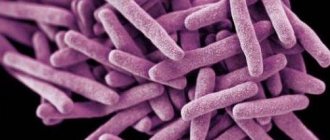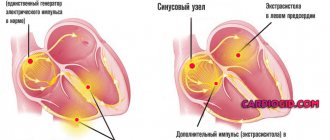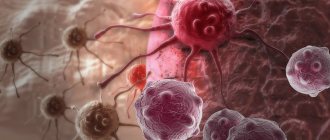Kidney cancer is a cancer that most often occurs in people between 55 and 60 years of age.
This pathology begins with the appearance in the renal tubules of malignant cells that can divide uncontrollably, thereby forming a tumor.
Without timely diagnosis and effective treatment, cancer can metastasize to neighboring organs and lead to death.
In nine cases out of a hundred, renal neoplasms are malignant, and only in one case does a cyst develop - a formation containing fluid.
Kidney cancer: causes
There are a huge number of carcinogens that provoke the development of oncology, but no specific cause of kidney cancer has yet been identified. But there are still a number of factors that have an indirect effect on the formation and progression of a malignant neoplasm. Among them are:
- Age.
After 50 years, the risk of developing a tumor increases several times. This is due to the accumulation of spontaneous genetic mutations that can give impetus to the formation of a cancer cell, long-term temporary contact with external negative factors and a decrease in immunity with age.
- Floor.
Bad habits, untimely treatment of diseases, and occupational hazards lead to the fact that symptoms of kidney cancer are much more common in men than in women.
- Overweight.
Extra pounds are most often the result of hormonal imbalance in the body. As a result, female sex hormones (estrogens) accumulate in adipose tissue, which, if certain factors coincide, can provoke the development of oncology.
- Smoking.
Among non-smokers, patients with kidney cancer are half as common as among those exposed to this bad habit. Substances contained in cigarettes and cigars have a powerful carcinogenic effect.
- Severe forms of kidney pathology.
Such diseases require long-term medication and maintenance of vital processes using dialysis (artificial kidney). The normal functioning of the kidneys becomes impossible, which contributes to the development of oncology.
- Prolonged contact with chemicals.
Various dyes, organic solvents, household chemicals and the like have a negative effect on the kidneys and other organs of the urinary system.
- Exposure to radiation and ionizing radiation.
Man-made disasters, polluted environmental conditions, and agricultural activities using radiation materials lead to malignant degeneration of kidney tissue.
- Genetic kidney pathologies.
Congenital anomalies of the anatomical structure of the organ, Hippel-Lindau disease, papillary cell carcinoma and others are risk factors in the development of a malignant process.
- Hereditary predisposition to malignant tumors.
If there is a history of kidney cancer in the family, the likelihood of this pathology occurring in close relatives increases significantly. Especially if brothers/sisters have the disease.
- Polycystic kidney disease.
The disease can be congenital or acquired. A characteristic feature is the formation of multiple bubbles filled with liquid. Cysts disrupt the functioning of the kidneys, thereby promoting the development of cancer.
- Hypertonic disease.
It is considered one of the aggravating factors in the formation of cancer tumors in the kidneys. It is still not completely clear what exactly is the trigger for cell degeneration - high blood pressure itself or regular use of antihypertensive drugs for a long time.
The presence of these factors does not indicate that kidney cancer will definitely appear. It also cannot be said that in the absence of these causes there will be no cancer. In each case of the disease, the history of its development is individual.
Some facts about the disease
Malignant pathology is spreading throughout the globe, but according to medical research, people in developed countries of Europe, North America, including Australia, are more often affected. That is, where there is an anxious and stressful life, plus unhealthy food. Where there is increased gas pollution (smog), the incidence of kidney cancer is higher. In the periphery, such as Latin America, India and China, the degree of damage to kidney cancer is lower. Fewer people get sick in these countries due to a special diet containing many phytoncides. Vegetables, nuts and seafood contain huge amounts of these substances.
But there are exceptions: Denmark and Sweden, they are famous for their low incidence of cancer pathologies of the kidneys and urinary system. People living in these countries prefer to eat fish, which contains polyunsaturated fatty acids, in particular omega 3, which is famous for its anti-cancer properties. In Russia, the incidence rate of cancer of the paired urinary organs ranks sixth among all oncological pathologies, and in the world Russia ranks fifth among all countries in the number of cases of kidney cancer. This is explained by an increased level of infectious and inflammatory kidney diseases and late detection of cancer.
Kidney cancer classification
Malignant parenchymal tumor of the kidney - what is it? In an organ, for a number of reasons, healthy cells degenerate into malignant ones and begin to divide uncontrollably, forming a tumor. Of all cases of kidney cancer, 90% are renal cell carcinoma. A cancerous tumor is formed from the epithelial tissue of the collecting ducts and renal tubules. If the epithelium of the pyelocaliceal system is involved in the malignant process, then it will be transitional cell carcinoma.
Renal cell carcinoma of the kidney is divided into the following subtypes:
- Clear cell carcinoma of the kidney. This type is also called hypernephroid cancer or Gravitz tumor. Consists of parenchymal epithelial tissue. A characteristic feature is the presence of a fibrous capsule, which encloses cancer cells in the initial stages of the disease.
- Chromophilic or papillary kidney cancer. With this type, the process is most often two-way.
- Chromophobe kidney carcinoma. It is rare and practically does not metastasize. After tumor removal, the prognosis is most often favorable.
- Oncocytic cancer. Characteristics are similar to the chromophobe form of cancer, but is formed from eosinophilic, rapidly growing large particles. The tumor can grow to large sizes.
- Collecting duct cancer. Of all cases of kidney cancer, this type occurs in only 1% of patients. It is distinguished by the migration of metastases throughout the body and the inflammatory process around the tumor.
- Williams tumor. Develops in childhood.
Among all types of kidney cancer, sarcoma is distinguished, which is characterized by damage to both kidneys, malignancy of the process, rapid metastasis and high mortality. Depending on the type of tissue affected, there are:
- angiosarcoma - vascular walls are affected;
- adenocarcinoma of the kidney - formed from glandular tissue;
- myosarcoma – muscle tissue is involved;
- fibrosarcoma - the basis of the tumor is connective tissue.
A classification of kidney cancer has been developed to determine the degree of malignancy of tumor cells. The indicator is denoted by the English word grade (abbreviated by the letter G), along with it a digital index for tumor differentiation is indicated:
- clear cell kidney cancer grade 1, the tissue is practically healthy and there are almost no changes;
- renal cell carcinoma of the kidney g2, a moderate degree of differentiation is noted;
- clear cell renal cell carcinoma of the kidney g3, poorly differentiated cells are available;
- kidney blastoma g4, cell differentiation does not occur, tumor tissue is significantly different from normal;
- clear cell kidney cancer Gx, the degree of differentiation is not determined.
The higher the number, the more malignant the process, indicating the aggressiveness of the tumor and an unfavorable prognosis.
For kidney cancer, the TNM classification is carried out, where:
- T – tumor size:
- Tx – there is no way to evaluate the tumor.
- 0 – no information about education.
- T1 – the tumor reaches up to 7 cm in diameter, but does not extend beyond the boundaries of the organ. 1a indicates formation up to 4 cm, 1b over 4 cm, but not more than 7.
- T2 – tumor is more than 7 cm, but does not cross the border.
- T3 - indicates damage to large veins and adrenal glands, but the tumor does not spread beyond the renal fascia. T3a – perinephric tissue or adrenal gland is affected. T3b – large vena cava below the diaphragm is affected. T3c – the tumor has grown into the wall of the inferior vena cava or has spread to this vein above the diaphragm.
- T4 – the neoplasm extends beyond the boundaries of the fascia.
- N – regional lymph nodes:
- Nx – it is not possible to identify lymph nodes.
- N0 – regional lymph nodes are not affected.
- N1 – metastases in a single lymph node.
- N2 – metastasis to a large number of lymph nodes is noted.
- M – distant metastases:
- Mx – distant metastases are not detected.
- M0 – metastasis is not diagnosed.
- M1 – distant metastases have appeared.
ICD 10 code for kidney cancer is C64, for oncology of the renal pelvis - C 65. ICD 10 code for cancer of the left kidney is C 64.1, right - C64.0.
Consultation before surgery
Your surgeon will talk to you immediately before your surgery. During your consultation, you will discuss possible risks and complications. In addition, the surgeon will warn you that in some cases during surgery it may be necessary to switch from laparoscopy to open removal of the kidney. As a rule, this probability exists in 5% of cases; previous inflammatory processes in the abdominal cavity or abdominal surgery increase this risk. During the consultation, you will be able to ask the surgeon all your questions. At the end of the conversation, you will need to sign an informed consent for surgical treatment.
The anesthesiologist will also talk to you before the operation. He will also provide you with complete information about the upcoming anesthesia, its risks and complications, and answer all your questions. At the end of the conversation, you will sign an informed consent for anesthesia.
Kidney cancer: symptoms and signs
The kidneys are a paired organ; they are located in the retroperitoneal space. Their main purpose is:
- urine formation
- removal of toxic substances and metabolic products
- maintaining blood pressure at an acceptable level
- hormone production
- participation in hematopoietic processes.
The tumor most often develops on one side, but sometimes bilateral lesions occur. Symptoms and signs of the disease in kidney oncology depend on many factors, including the stage of the process, the age of the patient, the general condition of the body, concomitant diseases, and the presence/absence of metastases.
In the first stages, there are usually no complaints; the disease is diagnosed accidentally. As the cancer process progresses, the patient's condition worsens. Increasing dysfunction, which invariably occurs with a kidney tumor, contributes to the appearance of characteristic symptoms.
Men and women share common specific and nonspecific symptoms and signs of kidney cancer. The first group includes the following complaints:
- Discomfort in the lumbar region.
Symptoms of kidney cancer include constant aching pain that occurs as a result of tumor compression of tissues, blood vessels and nerve endings. The patient notes pain in the abdomen and the projection area of the kidney on the side where the tumor forms. Over time, the pain becomes constant and more intense. When blood clots appear in the bladder, blockage of the ureter, tumor rupture or hemorrhage into the tumor, the functions of the urinary system are disrupted. All this causes acute severe pain, similar to that occurring with renal colic.
- The appearance of blood in the urine.
Blood in the urine may be a sign of kidney cancer. Very often it is discovered completely by accident, and there are no reasons that could cause hematuria. Bloody discharge disappears on its own, only to reappear after some time. As the condition worsens, hematuria can become one of the causes of blood loss, causing anemia.
- Determination of the formation of a dense consistency upon palpation of the lower back and abdomen.
When the disease moves to a more severe stage, in some cases it is possible to palpate the presence of a formation, especially if the patient is thin. The growth of the tumor to a significant size allows it to be felt even through the abdominal wall. This symptom is not always informative; its absence does not exclude kidney cancer.
In the early period, 1-2 symptoms are noted; as kidney cancer develops, the symptoms begin to appear in a complex.
You can suspect the presence of oncology based on nonspecific signs, including:
- persistent increase in blood pressure
- constant fatigue
- increased weakness
- excessive sweating (hyperhidrosis)
- untreatable swelling in the legs
- decreased or lack of appetite
- sudden weight loss.
How does kidney cancer manifest itself at stages 3–4? When metastases appear in various organs and systems, complaints appear related to disruption of their functions:
- when the lungs are affected, hemoptysis, persistent cough and shortness of breath are noted
- Metastases in the liver are indicated by jaundice of unknown origin and signs of liver failure
- pathological fractures and severe bone pain indicate tumor metastasis to bone tissue
- the brain and/or spinal cord affected by metastases reacts with severe headaches, dizziness, neuralgia and other neurological symptoms.
Frequently asked questions to the doctor
Precautionary measures
What to do if there is only one kidney left, how to live?
In order to maintain the health of the remaining organ, it is important to stop playing sports. When taking any medications, read the instructions first, because many of them have toxic effects.
Many concomitant diseases can cause deterioration of the organ. Therefore, undergo a preventive examination with a nutritionist, endocrinologist, or therapist. The main thing to do is to monitor the functional state of the only kidney.
Stages of kidney cancer and routes of metastasis
Depending on the size of the tumor, its growth into neighboring organs and metastasis, 4 stages of kidney cancer are distinguished:
- At the first stage, the formation is no more than 7 cm in diameter, is located within the organ and does not metastasize. There are no symptoms of the disease, only sometimes there is a low-grade fever and a dull aching pain on the side of the kidney affected by the pathological process. When diagnosed at this stage, the prognosis is most positive.
- In the second stage, the tumor reaches 10 cm and grows into the renal capsule, but does not extend beyond the boundaries of the organ’s fascia. At this stage of kidney cancer, metastases have not yet formed, malignant cells begin to differ from healthy ones, but the tumor itself grows quite slowly. There are no signs of cancer yet, but overall my health is getting worse. The patient is concerned about weakness, constant fatigue, lability of blood pressure, loss of appetite and weight.
- At the third stage, germination into nearby organs and penetration of malignant cells into the lymphatic system is noted. At this stage, the tumor on the kidney may involve the aorta and inferior vena cava. The main complaint is a persistent increase in blood pressure. In addition, the patient is concerned about liver problems, sudden weight loss, lack of appetite, disturbances in the gastrointestinal tract, urinary and respiratory systems.
- Stage 4 kidney cancer is characterized by a large tumor size, its invasion into the organs of the retroperitoneal space, and an aggressive course. With advanced kidney cancer, metastasis occurs throughout the body. The pain syndrome increases, the functioning of all organs and systems is disrupted.
Where else does kidney cancer metastasize? In 60% of oncology cases, metastases travel through the blood and lymph into the lungs. In addition, they are found in the brain, adrenal glands, bone tissue, liver, intestines, and bladder. In men, metastases can be in the prostate, in women - in the mammary gland. In some cases, pathological lesions may appear many years after the onset of the disease.
Remember, despite the presence of stage 4 kidney cancer, you need to move on with your life, the experienced specialists of our clinic in Moscow will help you with this. Oncologists of the highest qualification and having various scientific degrees are always ready to conduct diagnostics, develop a treatment protocol and immediately begin treatment.
How to identify kidney cancer
The presence of high-precision equipment in our clinic in Moscow allows us to detect kidney cancer at the very beginning of the disease. Unfortunately, most often this happens during examination for a completely different reason, because in the initial stages the incipient tumor does not manifest itself in any way. If a malignant neoplasm is suspected, after collecting an anamnesis, visual examination and palpation, the patient is prescribed the following types of examination:
- Instrumental. These include:
- Ultrasound examination. Internal organs, kidneys and retroperitoneal space are examined. Ultrasound determines the structure of the tumor in the kidney, location and size. Differential diagnostics are carried out to determine the type of process. An ultrasound can clearly determine whether a kidney tumor is developing, whether there is a benign mass formation or cysts. The only drawback is that if the patient is overweight, signs of kidney cancer on ultrasound are difficult to determine. The description of the study allows the attending physician to decide on treatment tactics in the future. The method is economical, informative and safe for the patient’s health, therefore it is widely used for diagnosis and screening.
- Computed tomography (CT). The accuracy of layer-by-layer X-ray examination reaches 95%. Of particular value is additional intravenous contrast. The use of this method makes it possible to determine the characteristics of a tumor in kidney cancer using the tnm system (size of formation, degree of damage to lymph nodes and the presence of metastases).
- Magnetic resonance therapy (MRI). In image sections of the affected organ obtained using an electromagnetic field, the location of the tumor, its structure, and the presence of metastases are clearly visible.
- Cystoscopy. Used as an additional remedy if a tumor formation in the bladder is suspected. A cystoscope is inserted through the urethra and the inner surface is examined to detect a tumor.
- Needle biopsy.
A puncture needle is inserted into the tumor tissue under the control of an ultrasound machine, then a piece of the affected tissue is removed with its help and a laboratory test is performed. Using IHC (immunohistochemistry), the classification of kidney cancer is determined.
- X-ray.
- Urography of the kidneys. There are survey, retrograde and intravenous research methods. In the first case, contrast is not used, in the second, the contrast agent is injected into the bladder through a catheter, in the third, intravenously. A series of x-rays are then taken. Symptoms of a kidney tumor on urograms include changes in the contours, size and location of the organs of the urinary system, as well as their functional state.
- Renal angiography. The contrast agent is injected through a special catheter into the aorta, located above the branch of the renal arteries. If kidney cancer is present, the tumor becomes clearly visible on photographs.
- Osteoscintigraphy (radioisotope scanning). Bone tissue is scanned using radioisotopes that tend to accumulate in places with a high level of metabolism, such as oncological formations.
- X-ray of the lungs.
Images are taken to detect distant metastases in the chest.
- Laboratory.
- General urine analysis. The absence/presence of blood, protein, and leukocytes in the urine is determined, which may indirectly indicate the presence of a pathological process in the kidneys and ureters.
- General blood analysis. It is prescribed to determine hemoglobin, leukocyte levels, the number of immature red blood cells and other signs of a malignant process.
- Blood chemistry. An increase in indicators such as creatinine, alkaline phosphatase, urea and uric acid is possible with the development of malignant tumors in the kidneys.
- Blood for tumor markers.
A tumor marker is a specific protein produced by tumor cells or the body itself. In kidney cancer, different types of tumor markers are determined, but first of all, attention is paid to the NSE marker. Exceeding its indicators signals the presence of a pathological process, but to make a more accurate diagnosis, a number of additional studies should be carried out.
Our clinic is equipped with modern equipment, the examinations of which are carried out by highly qualified specialists, which eliminates errors in diagnosis. Detection of the disease at the initial stages allows you to preserve the kidneys and the same quality of life without the use of drastic measures.
Diagnostics
Diagnostic device
In order to identify cancer and its signs in men or manifestations in women, a number of important measures are carried out, including:
- Ultrasound diagnostics. The kidneys, retroperitoneal lymph nodes, and abdominal organs are examined. This makes it possible to identify a nodular formation in the affected organ. The doctor can determine the size of the tumor and also see whether adjacent tissue is involved in the pathological process.
- Puncture biopsy - performed after ultrasound, MRI or CT if it was not possible to identify the full picture of the pathological process. It is possible to determine whether a formation is malignant or benign with 100% accuracy.
- MRI, CT – the affected organ is examined in more detail; metastasis can be confirmed or refuted.
- Cytoscopy. The bladder area is examined using an endoscope.
- Angiography is a method that is relevant when the tumor reaches a large size. The renal vessels are examined using intravenous contrast. It is also possible to assess whether large vessels located nearby are involved in the pathological process.
- Scintigraphy. The kidneys are examined, the doctor assesses their condition and the degree of damage.
- Excretory urography is something more than radiography, because this method is already considered outdated.
Patients are required to undergo blood and urine tests. Based on the results of the examination, the doctor can make an accurate diagnosis and the stage of development of the disease.
Treatment
Treatment tactics for a kidney tumor are selected depending on the stage of the process, location and general condition of the patient. How long you live with a kidney tumor after symptoms appear depends on when treatment is started. Timely therapy at the first stage helps to achieve stable remission and significantly reduce the risk of metastases that worsen the life prognosis. According to clinical recommendations, surgical treatment and alternative methods are prescribed for kidney tumors.
The most optimal treatment option is surgery, which achieves long-term remission. There are several types of operations to remove a kidney with a tumor:
- Kidney resection. For cancer, it is used if the tumor is small in size (no more than 4 cm), the only kidney is affected, dysfunction is observed in the second kidney, or the patient is at a relatively young age. A third or half of the kidney is removed along with the tumor.
- Nephrectomy. If the disease has reached stage 2 or growth of the tumor into the renal pelvis is observed, but the second kidney is working normally, then an operation is performed to completely remove the kidney with the tumor.
- Combined method. Indicated if the tumor reaches a large size or grows into surrounding tissues. surgery to remove a kidney with a tumor; in addition to the kidney, parts of nearby organs and large vessels are removed.
The consequences after removal of a kidney with a tumor can be different, ranging from damage to surrounding organs and ending with profuse bleeding. After resection, recurrence of kidney cancer is possible; this is facilitated by undetected and accidentally left malignant cells.
During the rehabilitation period after removal of a kidney with a cancerous tumor, adequate physical activity, avoidance of heavy lifting, and compliance with the recommendations of the attending physician are necessary.
After surgery, chemotherapy is prescribed to prevent relapse and spread of metastases. If drugs are prescribed after surgery, then we are talking about adjuvant chemotherapy. In cases where surgery is not possible due to the presence of a tumor in the last stage, neoadjuvant treatment is performed. Recently, insensitivity of cancer cells to chemotherapeutic agents has become common, and drugs in this group have a very negative effect on human organs and systems, so more modern treatment methods are increasingly being used for kidney oncology.
Innovative developments in the field of medicine make it possible to treat kidney tumors without surgery. The following methods are used:
- Renal artery embolization.
When using this method, the afferent artery is blocked, as a result of which the substances necessary for growth cease to flow to the tumor. As a result, the formation may be significantly reduced in height.
- Radiation therapy.
Prescribed as palliative treatment to relieve pain and improve general well-being. It also helps slow down the spread of cancer in the body. The tumor itself is practically insensitive to radiation exposure.
- Immunotherapy.
For kidney cancer, it is prescribed in combination with radiation and is used to activate protective forces. Immunotherapy can be specific when the vaccine is based on heat shock protein and tumor tissue. If the vaccine consists of peptides and embryonic cells, then we are talking about nonspecific immunotherapy. After removal of a kidney without metastasis, using this method in cancer patients reduces the relapse rate by 10%. The vaccine has no effect on metastases.
- Cryo- or radioablation of the tumor.
A high-frequency current or nitrous oxide is applied through a probe to the tumor-like formation in the kidney. In this case, a limited tumor is completely eliminated; in the case of an accumulation of several nodes, the main one is “burned out.”
- Innovative treatment methods:
- Targeted therapy. For kidney cancer, drugs are prescribed whose action is aimed at destroying specific proteins produced by the malignant tumor. As a result, the growth of the formation slows down, the uncontrolled proliferation of pathological cells stops and metastases do not form. The negative aspects of using this method are the rapid adaptation of tumor cells to the drugs and a large number of side effects. Most often, targeted therapy is used in combination with other treatments.
- Gene therapy. The division of pathogenic cells is affected at the gene level. The introduction of pre-modified cells helps stop tumor growth and achieve its regression.
- Neutron therapy. Irradiation is carried out with microparticles in which there is no electrical charge. As a result, they penetrate deep into the malignant cell and attract toxic substances, due to which the tumor grows. In this case, there is no damage to healthy tissue. Neutron therapy has a positive effect on the body even in the presence of 3-4 stages of cancer, especially if the tumor is pre-impregnated with boron, gadolinium or cadmium before the procedure.
- Chemoembolization. Standard chemotherapy for kidney cancer is ineffective, while local chemotherapy leads to positive results. During the procedure, the blood flow going to the tumor and feeding it is blocked. Then a drug with an antitumor effect is injected into the artery.
Treatment for a tumor of 2 kidneys consists of preserving the function of at least one organ of the pair as much as possible. If this is not possible, then the issue of transplanting a donor kidney has to be addressed.
Postoperative period
The duration of rehabilitation of the operated patient depends on the stage of the disease, the complexity of the operation, the age of the patient and his general condition. After removal of a kidney, some complications may arise in the form of pneumonia, thrombophlebitis, and problems with the cardiovascular system.
In the first few days after nephrectomy, a person is contraindicated to move, drink a lot of fluids and eat.
Rehabilitation can last on average a year and a half. During this period, the patient should minimize physical activity and adhere to the prescribed diet. It is prohibited to consume alcohol, fried foods and smoked foods.
Over time, with the permission of the doctor, you can increase physical activity, strengthen the body, drink more clean warm water or rosehip decoction and gradually introduce new foods into the diet.
A prerequisite for a high-quality and fulfilling life after surgery is regular visits to oncologists, undergoing examinations and passing all necessary tests.
Life prognosis for kidney cancer
When asked how long people live with kidney cancer, experts give an ambiguous answer. It all depends on:
- at what stage was the tumor detected?
- the malignant process is occurring within the renal capsule or has already gone beyond it
- whether pathological cells have entered the lymphatic system or not
- whether there are metastases to other organs.
If 5 or more years have passed after the treatment, and remission continues, then with a greater degree of probability it can be said that a relapse will not occur.
The prognosis after removal of g3 clear cell renal cell carcinoma, if detected at an early stage, is very optimistic. If cancer is detected at the first stage after proper treatment, stable remission is observed in 90% of patients, and the five-year survival rate is within 80%. For stage 2 clear cell renal cell carcinoma, the prognosis is less favorable. The five-year survival rate is 74%.
After removal of stage 3 kidney cancer, according to the forecast, the five-year survival rate is 50% of all cases of the disease. If surgery was performed against the background of metastasis, then according to forecasts, after removal of kidney cancer, only 5% of patients survive for five years.
If kidney cancer is detected at stage 4, the prognosis, in the absence of adequate treatment, is extremely unfavorable. In this case, to the question of how long they live after the onset of symptoms of kidney cancer, the answer is the same for women and men: if the tumor is not removed, then death occurs after one, maximum two years.
How and how long people live with one kidney after cancer largely depends on the patients themselves. Following the recommendations of the oncologist, maintaining a healthy lifestyle and a positive attitude can significantly increase this indicator.
Targeted therapy
Recently, this method has increasingly begun to be used to treat kidney cancer. The desired effect on the cancerous tumor is achieved with the help of medications.
Cancer cells die. Interestingly, the patient is practically not bothered by side effects, healthy cells and organs do not suffer.
Carrying out treatment
Such drugs perfectly complement chemotherapy or radiotherapy. Some doctors even prescribe them as a preventive measure for cancer.
The cancer tumor stops its development at the molecular level. The cancerous tissue dies and does not affect the healthy part of the organ. As for the duration of the course of treatment, it depends solely on the stage of development of the disease and the general condition of the patient.
Treatment of kidney cancer in Moscow
Tumor diseases of the kidneys require increased attention from specialists. Our oncology clinic in Moscow is ready to accept patients with this disease for treatment. We have all the resources for this:
- the most accurate diagnostic equipment
- modern consumables
- experienced oncologists with the highest qualification category and scientific degrees
- staff specially trained to care for postoperative patients
- dietary food
- comfortable rooms.
The scientific developments of our specialists contribute to the detection of kidney oncology at the initial stages and the successful fight against the disease. You can find out how much an operation to remove a kidney tumor costs by calling the phone number provided.
Dietary requirements
Cancer of any organ requires strict adherence to a diet. The regimen and composition of dietary nutrition are determined by doctors. They recommend eliminating foods that put stress on the kidneys from your diet:
- smoked food;
- carbonated drinks;
- pickled and salty dishes;
- strong tea, coffee;
- sweets;
- canned fish and meat;
- different types of legumes;
- rich fish and meat broths;
- sausages;
- fatty meat dishes.
Patients with cancer should not drink alcoholic or low-alcohol drinks.
A proper diet should include:
- plant foods;
- cereal dishes;
- chicken and quail eggs;
- fruits;
- dairy products.
In small quantities you can use:
- boiled lean meat and fish;
- butter and cream;
- salt and spices.
You should also limit the amount of fluid you drink to 1 liter to avoid stress on your kidneys.











